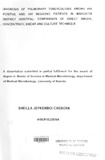| dc.description.abstract | Introduction: Tuberculosis(TB) has probably killed more people than other diseases in history. The number of yearly deaths due to TB has continued to increase and is now over two million with a death occurring every 15 seconds. Pulmonary Tuberculosis (PTB) remains a major public health threat and has been fuelled by the concurrent Human immunodeficiency Virus (HIV) epidemic. HIV infection is known to be a potent risk for reactivation of latent infection and also increases the risk of progression to disease of newly acquired infection. ** Objectives: To determine the yield of concentrate smear and culture over the yield of direct smear and to determine the prevalence of Mycobacterium tuberculosis (MTB) and Mycobacteria Other Than Tuberculosis (MaTT) in culture positive specimens in HIV positive and negative patients. To determine specific socio demographic factors on positive results. ** Study design: A cross-sectional descriptive study that was carried between August and November 2006. ** Study population: New patients attending Mbagathi District Hospital chest clinic with history of cough over three weeks. A sample of 150 adult patients was drawn for the study by systematic random sampling selecting every third patient who fulfilled the selection criteria. Methodology: Three smears for direct and concentrate were made from each sputum specimen, stained with Ziel Neelsen and examined microscopically. All concentrate specimens were cultured on LJ and MGIT 960 system and growth identified as MTB or MOTTbased on colonial morphology and biochemical tests. Data analyses: Descriptive statistics were generated from Statistical Package for Social Sciences (SPSS) version 12.0 and Microsoft Excel (MS excel). ** Results: Of the 150 patients included in the study, direct microscopy was positive in 53 representing 35.3 %. Smears were positive in 43 (47.8%) HIV+ patients and in10 (16.7%) HIV- patients. In the concentrate smear microscopy technique, a yield of 79 (52.7%) representing an incremental yield of 26 (17.4%). Among the HIV+ patients smears were positve in 63 (70%) and 16 (26.7% was obtained from HIV- patients (p <O.ooot). Concentration of the sputum samples increased the sensitivity from 62% to 87%. In the culture method a yield of .Eighty five (56.7%) of culture yielded growth representing 32 (21.4%) compared to direct microscopy and 6 (4%) concentrated smear microscopy. The culture contamination rate was 3.3%. Seventy five percent of the culture positive cases were from HIV+ and 40% were from HIV- (p value of <0.0001) Of the 85 Mycobacteria isolated, 78 (91.8%) were MTS and 7 (8.2%) were
MOTT. Among the TS/HIV co-infected patients, 58 (90%) isolates were MTS and 6 (10%) were MOTT. While among the HIV- patients 20 (95.2%) isolates were MTB and 1 (4.8%) was MOTT. The specific socio demographic characteristics of the study population had a major impact on the infection of tuberculosis. Age group most infected was 23-37 years, males (55%) and married patients had a high rate of infection, Conclusion: The concentration method substantially increased the yield and sensitivity of direct microscopy. LJ culture medium had a considerable advantage for diagnosis, identification and antimicrobial sensitivity, but its relatively long time for isolation makes it a less recommendable option for widespread use in routine district laboratories. | en_US |

